Kenwood KDC-8020 User Manual

KDC-8020 |
CD-RECEIVER |
INSTRUCTION MANUAL |
© B64-2149-00 (M)
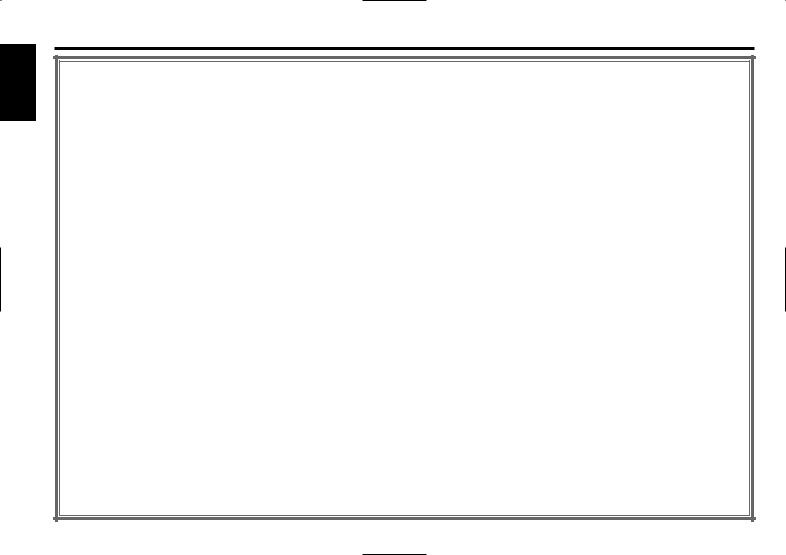
English
Contents
Safety precautions |
......................3 |
CD/External disc control |
|
About CDs |
5 |
features .................................. |
13 |
|
|
General features .........................6 |
Playing CD |
|
Playing External Disc |
||
Power |
||
Fast Forwarding and Reversing |
||
Selecting the Source |
||
Track Search |
||
Volume |
||
Album Search |
||
Attenuator |
||
Direct Track Search |
||
Loudness |
||
Direct Album Search |
||
Switching Display |
||
Track/Album Repeat |
||
Switching Clock Display |
||
Track Scan (Function of CD/MD) |
||
System Q |
||
Random Play |
||
Audio Control |
||
Magazine Random Play |
||
Speaker Setting |
||
Text/Title Scroll |
||
Station/Disc Naming (SNPS/DNPS) |
||
DNPP (Disc Name Preset Play) |
||
Auxiliary Input Display Setting |
||
Menu system.............................17 |
||
Faceplate Angle Adjustment |
||
Menu System |
||
Theft Deterrent Faceplate |
||
Security Code |
||
Hiding the Control Panel |
||
Touch Sensor Tone |
||
Tuner features...........................11 |
||
Manual Clock Adjustment |
||
Tuning Mode |
||
Selectable Illumination |
||
Tuning |
||
Switching Graphic Display |
||
Direct Access Tuning |
||
Contrast Adjustment |
||
Station Preset Memory |
||
Dimmer |
||
Auto Memory Entry |
||
OFF Wait Time Setting |
||
Preset Tuning |
||
System Q |
||
Frequency Step Setting |
||
B.M.S. (Bass Management System) |
||
|
||
|
CRSC (Clean Reception System Circuit) |
|
|
Text Scroll |
Basic Operations of remote...... |
21 |
Loading and Replacing the battery |
|
Basic operations |
|
In Tuner source |
|
In Disc source |
|
Accessories............................... |
23 |
Installation Procedure .............. |
23 |
Connecting Wires to |
|
Terminals................................ |
24 |
Installation |
|
(non-Japanese cars) ............... |
25 |
(Japanese-cars)....................... |
25 |
Removing the Unit.................... |
26 |
Locking the faceplate |
|
to the unit .............................. |
26 |
Troubleshooting Guide ............. |
27 |
Specifications ........................... |
30 |
— 2 —

Safety precautions
2WARNING |
2CAUTION |
To prevent injury or fire, take the following precautions:
•Insert the unit all the way in until it is fully locked in place. Otherwise it may fall out of place when jolted.
•When extending the ignition, battery, or ground wires, make sure to use automotivegrade wires or other wires with a 0.75mm2 (AWG18) or more to prevent wire deterioration and damage to the wire coating.
•To prevent a short circuit, never put or leave any metallic objects (such as coins or metal tools) inside the unit.
•If the unit starts to emit smoke or strange smells, turn off the power immediately and consult your Kenwood dealer.
•Make sure not to get your fingers caught between the faceplate and the unit.
•Be careful not to drop the unit or subject it to strong shock.
The unit may break or crack because it contains glass parts.
•Do not touch the liquid crystal fluid if the LCD is damaged or broken due to shock. The liquid crystal fluid may be dangerous to your health or even fatal.
If the liquid crystal fluid from the LCD contacts your body or clothing, wash it off with soap immediately.
To prevent damage to the machine, take the following precautions:
•Make sure to ground the unit to a negative 12V DC power supply.
•Do not open the top or bottom covers of the unit.
•Do not install the unit in a spot exposed to direct sunlight or excessive heat or humidity. Also avoid places with too much dust or the possibility of water splashing.
•Do not subject the faceplate to excessive shock, as it is a piece of precision equipment.
•When replacing a fuse, only use a new one with the prescribed rating. Using a fuse with the wrong rating may cause your unit to malfunction.
•To prevent a short circuit when replacing a fuse, first disconnect the wiring harness.
•Do not place any object between the faceplate and the unit.
•Do not use your own screws. Use only the screws provided. If you use the wrong screws, you could damage the unit.
•Do not apply excessive force to the moving faceplate. Doing so will cause damage or malfunction.
•Do not apply excessive force to the open faceplate or place objects on it. Doing so will cause damage or breakdown.
Do Not Load 3-in. CDs in the CD slot
If you try to load a 3 in. CD with its adapter into the unit, the adapter might separate from the CD and damage the unit.
— 3 —
IMPORTANT INFORMATION
About the disc changer to be connected:
To connect a disc changer having the "O-N" switch to this unit, set the "O-N" switch to "N". When you connect a model with no "O-N" switch, the converter cord CA-DS100 available as an option may be required. For details, consult your Kenwood dealer.
A disc changer doesn't work when it is connected without using these options.
If a model with no "O-N" switch is connected, some unavailable functions and information that cannot be displayed are generated. Note that none of the KDC-C100, KDC-C302, C205, C705, and non-Kenwood CD changers can be connected.
You can damage both your unit and the CD changer if you connect them incorrectly.
The marking of products using lasers (Except for some areas)
CLASS 1
LASER PRODUCT
The label is attached to the chassis/case and says that the component uses laser beams that have been classified as Class 1. It means that the unit is utilizing laser beams that are of a weaker class. There is no danger of hazardous radiation outside the unit.
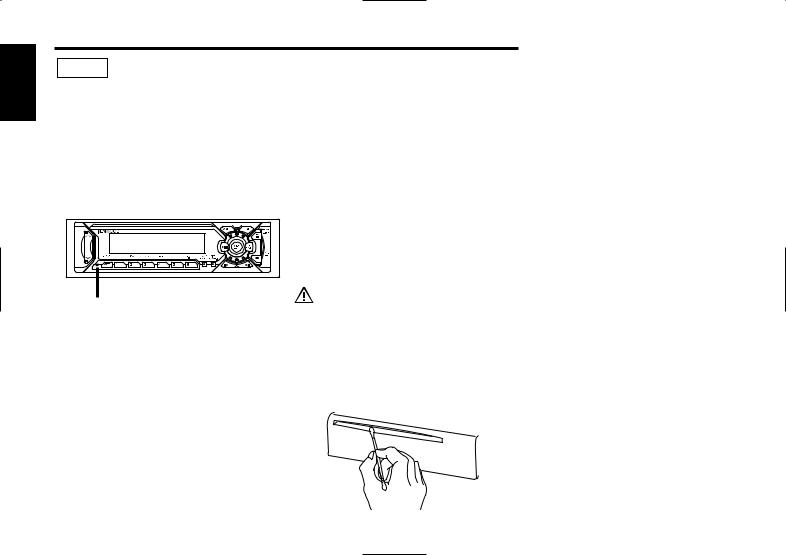
English
Safety precautions
NOTE
•If you experience problems during installation, consult your Kenwood dealer.
•If the unit fails to operate properly, press the Reset button. The unit returns to factory settings when the Reset button is pressed. If the unit still fails to operate properly after the Reset button has been pressed, contact your local KENWOOD dealer for assistance.
•Press the reset button if the disc auto changer fails to operate correctly. Normal operatin should be restored.
Reset button
•We recommend the use of the Security Code function (see p. 18) to prevent theft.
•Characters in the LCD may become difficult to read in temperatures below 41 ˚F (5 ˚C).
•The illustrations of the display and the panel appearing in this manual are examples used to explain more clearly how the controls are used. Therefore, what appears on the display in the illustrations may differ from what appears on the display on the actual equipment, and some of the illustrations on the display may represent something impossible in actual operation.
Lens Fogging
Right after you turn on the car heater in cold weather, dew or condensation may form on the lens in the CD player of the unit. Called lens fogging, CDs may be impossible to play. In such a situation, remove the disc and wait for the condensation to evaporate. If the unit still does not operate normally after a while, consult your Kenwood dealer.
Cleaning the Faceplate Terminals
If the terminals on the unit or faceplate get dirty, wipe them with a dry, soft cloth.
Cleaning the Unit
If the faceplate of this unit is stained, wipe it with a dry soft cloth such as a silicon cloth.
If the faceplate is stained badly, wipe the stain off with a cloth moistened with neutral cleaner, then wipe neutral detergent off.
Applying spray cleaner directly to the unit may affect its mechanical parts. Wiping the
faceplate with a hard cloth or using a volatile liquid such as thinner or alcohol may scratch the surface or erases characters.
Cleaning the CD Slot
As dust tends to accumulate in the CD slot, clean it every once in a while. Your CDs can get scratched if you put them in a dusty CD slot.
— 4 —

About CDs
Handling CDs
• Don’t touch the recording surface of the CD.
•CD-R and CD-RW are easier to damage than a normal music CD. Use a CD-R or a CD-RW after reading the caution items on the package etc.
•Don’t stick tape etc. on the CD.
Also, don’t use a CD with tape stuck on it.
When using a new CD
If the CD center hole or outside rim has burrs, use it after removing them with a ball pen etc.
Burrs
Burrs
CD accessories
Don’t use disc type accessories.
CD cleaning
Clean from the center of the disc and move outward.
Removing CDs
When removing CDs from this unit pull them out horizontally.
CDs that can’t be used
• CDs that aren’t round can’t be used.
•CDs with coloring on the recording surface or that are dirty can’t be used.
•Don’t use CDs without disc mark


 .
.
•A CD-R or CD-RW that hasn’t been finalized can’t be played. (For the finalization process refer to your CD-R/CD-RW writing software, and your CD-R/CD-RW recorder instruction manual.)
CD storage
•Don’t place them in direct sunlight (On the seat or dashboard etc.) and where the temperature is high.
•Store CDs in their cases.
—5 —
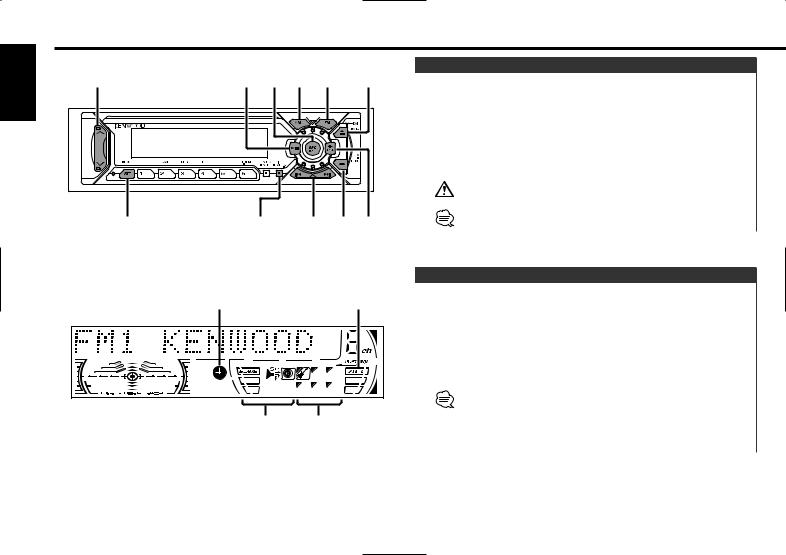
English |
General features |
|
|
|
|
|
|
|
|
|
|
|
|
Turn the vehicle ignition ON. |
|
|
|
|
|
|
|
|
Power |
|
u / d |
38 |
SRC |
AM |
FM |
ANG |
Turning ON the Power |
|
|
||||||
|
|
|
|
|
|
|
The faceplate reverses and control panel is displayed. |
|
|
|
|
|
|
|
Turing OFF the Power |
|
|
|
|
|
|
|
Turn the vehicle ignition OFF. |
|
|
|
|
|
|
|
When the set time for removing the faceplate (page 19) lapses, |
|
|
|
|
|
|
|
the faceplate reverses and the control panel is hidden. |
|
|
|
|
|
|
|
Do not apply force to the faceplate during operation. It can cause |
|
|
|
|
|
|
|
damage. |
|
ATT / LOUD |
DISP / NAME.S |
4 / ¢ CLK |
Q / AUD |
When the power is ON, the <Security Code> (page 18) is displayed |
||
|
as "CODE ON" or "CODE OFF". |
||||||
|
|
|
|
|
|
|
|
Clock indicator |
ATT indicator |
Speaker Setting SYSTEM Q indicator indicator
Selecting the Source
Press the [SRC] button. |
|
Source required |
Display |
Tuner |
"TUNER" |
CD |
"CD" |
External disc |
"DISC"/"CD2" |
Auxiliary input |
"AUX" |
Standby (Illumination only mode) |
"ALL OFF" |
For Auxiliary input one of the below optional accessories is necessary.
-KCA-S210A
-CA-C1AX
-CD changer with an Auxiliary input function installed.
— 6 —

Volume
Increasing Volume
Press the [u] button.
Decreasing Volume
Press the [d] button.
Attenuator
Turning the volume down quickly.
Press the [ATT] button.
Each time the button is pressed the Attenuator turns ON or OFF. When it’s ON, the "ATT" indicator blinks.
Loudness
Compensating for low and high tones during low volume.
Press the [LOUD] button for at least 1 second.
Each time the button is pressed for at least 1 second the Loudness turns ON or OFF.
When it's ON, "LOUD ON" is displayed.
Switching Display
Switching the information displayed.
Press the [DISP] button.
Each time the button is pressed the display switches as shown below.
In Tuner source |
|
|
|
Information |
Display |
|
Frequency |
|
|
Station name |
"SNPS" |
In CD & External disc source |
|
|
|
Information |
Display |
|
Track Time |
|
|
Disc name |
"DNPS" |
|
Disc title (In External disc source) |
"D-TITLE" |
|
Track title (In External disc source) |
"T-TITLE" |
Switching Clock Display
Switching the displayed information.
Press the [CLK] button.
Each time the button is pressed it switches between clock display and current source.
During clock display the clock indicator is ON.
— 7 —
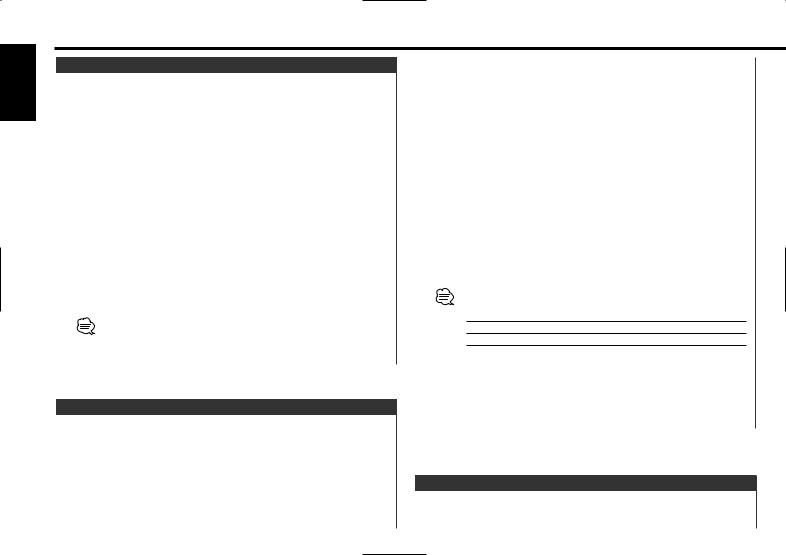
English
General features
System Q
You can recall the best sound setting preset for different types of the music.
1Select the source to set
Press the [SRC] button.
2Select the Sound type
Press the [Q] button.
Each time the button is pressed the sound setting switches.
Sound setting |
Display |
Flat |
"Flat" |
Rock |
"Rock" |
Top 40 |
"Top 40" |
Pops |
"Pops" |
Jazz |
"Jazz" |
Easy |
"Easy" |
Scan of Flat — Easy |
"Scan" |
User memory |
"User" |
•User memory: The values set on the <Audio control> (page 8).
•Each setting value is changed with the <Speaker setting> (page 8).
First, select the speaker type with the Speaker setting.
switch as shown below.
4Adjust the Audio item
Press the [4] or [¢] button.
Adjustment Item |
Display |
Range |
Bass Center Frequency |
"Bass F" |
60/70/80/100 or 150 Hz |
Bass level |
"Bass" |
–8 — +8 |
Bass Q Factor |
"Bass Q" |
1.00/1.25/1.50/2.00 |
Bass Extend |
"Bass EXT" |
ON/OFF |
Middle Center Frequency |
"MID F" |
0.5/1.0/1.5/2.0 kHz |
Middle level |
"Middle" |
–8 — +8 |
Middle Q Factor |
"Middle Q" |
1.0/2.0 |
Treble Center Frequency |
"TRE F" |
10.0/12.5/15.0/17.5 kHz |
Treble level |
"Treble" |
–8 — +8 |
Balance |
"Balance" |
Left 15 — Right 15 |
Fader |
"Fader" |
Rear 15 — Front 15 |
Volume offset |
"V Offset" |
–8 — ±0 |
•According to the Bass Q Factor setting value, the frequencies that can be set in Bass Center Frequency change as shown below.
Bass Q Factor |
Bass Center Frequency |
1.00/1.25/1.50 |
60/70/80/100 |
2.00 |
60/70/80/150 |
•When the Bass Extend is set to ON, low frequency response is extended by 20%.
•Volume offset: Each source's volume can be set as a difference
from the basic volume.
Audio Control
1Select the source for adjustment
Press the [SRC] button.
2Enter Audio Control mode
Press the [AUD] button for at least 1 second.
3Select the Audio item for adjustment
Press the [FM] or [AM] button.
Each time the button is pressed the items that can be adjusted
5Exit Audio Control mode
Press the [AUD] button.
Speaker Setting
Fine-tuning so that the System Q value is optimal when setting the speaker type.
— 8 —
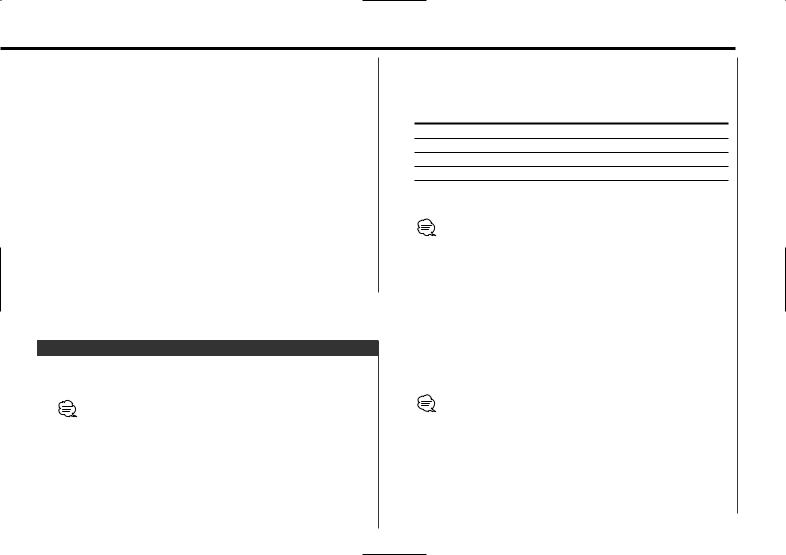
1Enter Standby
Press the [SRC] button.
Select the "ALL OFF" display.
2Enter Speaker Setting mode
Press the [Q] button.
3Select the Speaker type
Press the [4] or [¢] button.
Each time the button is pressed the setting switches as shown below.
Speaker type |
Display |
|
OFF |
|
"SP OFF" |
For 6 |
& 6x9 in. speaker |
"SP 6*9/6inch" |
For 5 |
& 4 in. speaker |
"SP 5/4inch" |
For the OEM speaker |
"SP O.E.M." |
|
4Exit Speaker Setting mode
Press the [Q] button.
Station/Disc Naming (SNPS/DNPS)
Attaching a title to a Station or CD.
1Receive/play the station/disc you want to attach a title to
•A title can't be attached to a MD.
•Disc Naming can't be done during CD text display.
2Enter name set mode
Press the [NAME.S] button for at least 2 seconds.
"NAME SET" is displayed.
3Move the cursor to the enter character position
Press the [4] or [¢] button.
4Select the character type
Press the [38] button.
Each time the button is pressed the character type switches as shown below.
Character type
Alphabet upper case Alphabet lower case Numbers and symbols
Special characters (Accent characters)
5Select the characters
Press the [FM] or [AM] button.
Characters can be entered by using a remote with a number
buttons. |
|
|
Example: If "DANCE" is entered. |
|
|
Character |
Button |
#Times pressed |
"D" |
[#3] |
1 |
"A" |
[#2] |
1 |
"N" |
[#6] |
2 |
"C" |
[#2] |
3 |
"E" |
[#3] |
2 |
6Repeat steps 3 through 5 and enter the name.
7Exit name set mode
Press the [NAME.S] button.
•When operation stops for 10 seconds the name at that time is registered, and Name Set mode closes.
•Memory numbers
-FM: 32 stations
-AM: 16 stations
-Internal CD player: 30 discs
-External CD changer/ player: Varies according to the CD changer/ player. Refer to the CD changer/ player manual.
•The title of station/CD can be changed by the same operation used to name it.
— 9 —
